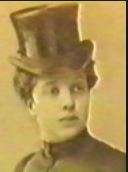Maria Nirod
Countess Maria Nirod (24 May 1879 – 11 October 1965) was a maid of honour in the imperial court of Tsar Nicholas and Alexandra of Russia. After her husband's death, she trained as a surgical nurse and assisted in the surgery of Dr. Vera Gedroits, who would become her life partner. After serving as a nurse in World War I and during the Russian Revolution, she fled with her children to Kiev. She served as a surgical nurse in Kiev until Gedroits' death and later ran a pharmacy which provided medications to the poor.
Maria Nirod | |
|---|---|
Мария Дмитриевна Муханова | |
 | |
| Born | Maria Dmitrievna Mukhanova 24 May 1879 Tsarskoye Selo, St. Petersburg, Imperial Russia |
| Died | 11 October 1965 (aged 86) |
| Nationality | Russian, Ukrainian |
| Other names | Maria Dmitrievna Nirod-Mukhanova, Maria von Nierodt |
| Occupation | nurse |
| Years active | 1913–1932 |
Early life
Maria Dmitrievna Mukhanova was born on 24 May 1879 in Tsarskoye Selo at St. Petersburg in Imperial Russia[1] to Maria Alexandrovna (née Kovalkova) and Dmitry Ilyich Mukhanov.[2] She was descended through her maternal great-grandmother Vera Vasilievna Lukashevich-Trepova (Russian: Вера Васильевна Лукашевич-Трепова) of Ukrainian aristocrats, including Hetman, Petro Doroshenko; Ivan Skoropadsky, Danylo Apostol, and Judge Vasyl Kochubey.[3][4] Mukhanova served in the Imperial Palace as a maid of honour.[1] On 3 February 1903, she married Count Feydor Mikhailovich Nirod,[1] an adjutant's aide and Lieutenant in the Equestrian Regiment of the Imperial Guard.[5] His family descended from Karl von Nierodt (von Nieroth), commander of the Knights of the Teutonic Order.[6] They would have two children, Feydor (1907–1996) and Marina.[1] The count died in 1913 at the age of thirty-six, after undergoing an unsuccessful surgery.[5] His death plunged Nirod into a mental breakdown and she spent a year undergoing treatment in St. Petersburg and Wiesbaden, before returning to Tsarskoye Selo to care for her children.[4]
Career
At the outbreak of World War I the Hospital at Tsarskoye Selo was prepared for war and Vera Gedroits trained noble women to work there as nurses.[7] Nirod trained as a surgical nurse and worked in the hospital.[4] She and her children lived in the dormitory of the palace and were neighbors of Gedroits.[6] By the outbreak of the February Revolution the safety of nobles in St. Petersburg was insecure. Under the protection of a former senator and the monks from the Kiev Pechersk Lavra, Nirod and her children, along with Maria Nikolaevna Ignatieva, Zoya Nikolaevna Rodzianko fled from Leningrad and arrived in Kiev[1] in 1918.[1][8] After some months in the monastery, Nirod and Gedroits along with the children moved to an apartment on Kruglouniversitetskaya Street. The two women lived as a married couple, which prompted both anger and admiration from Nirod's children.[8]
As she had in St. Petersburg, the Countess served as a surgical nurse to Gedroits. They were arrested many times. Nirod's son recalled an incident where he returned to the house finding officers inside, who arrested his mother and her lover. The couple disappeared for some months and then miraculously returned. According to their neighbor, the artist, Irina Dmitrievna Avdiyeva, Gedroits had once successfully operated on a powerful benefactor, who always secured their release.[8] After Gedroits was removed from her faculty post in 1930, she bought a farm on the outskirts of Kiev, where the couple would live until her death in 1932.[9] After Gedroits died, the property was sold and Nirod lived for a time at the Vvedenskyi Monastery.[1] Later, she bought a property in the village of Trotsche near the city of Zhytomyr, where she operated a pharmacy, providing free medicines to the poor.[4]
Death and legacy
Near the end of her life, Nirod suffered from dementia.[4] She died on 11 October 1965 in Kiev and was buried in the Baikove Cemetery.[1] Her son, Feydor became an artist, who was most known for his scenographic work for the National Opera of Ukraine.[4]
References
Citations
Bibliography
- Гедройц (Gedroits), Александр (Alexander) (5 December 2015). "Правду утверждай жизнью" [Confirm Life with Truth (pt 1)]. istpravda.ru (in Russian). Историческая правда. Archived from the original on 8 June 2018. Retrieved 8 June 2018. and Гедройц (Gedroits), Александр (Alexander) (14 December 2015). "Правду утверждай жизнью Часть 2" [Confirm Life with Truth (pt 2)]. istpravda.ru (in Russian). Историческая правда. Archived from the original on 8 June 2018. Retrieved 8 June 2018.
- Константинова (Konstantinova), Екатерина (Ekaterina) (18 May 2007). "Двести лет одиночества" [Two hundred years of loneliness] (in Ukrainian). Kiev, Ukraine: Зеркало недели (Weekly Mirror). Retrieved 9 June 2018.
- Мец (Metz), А.Г. (A. G.) (1992a). "Новое о Сергее Гедройц. 3. Из Воспоминаний И.Д. Авдиевой" [New on Sergei Gedroits: 3. From Memories I.D. Avdievoy]. Лица. Биографический альманах (in Russian). St. Petersburg, Russia: Феникс. Archived from the original on 17 November 2017. Retrieved 8 June 2018.
- Мец (Metz), А.Г. (A. G.) (1992b). "Новое о Сергее Гедройц. Биография В. И. Гедройц" [New on Sergei Gedroits: Biography of VI Gedroits]. Лица. Биографический альманах (in Russian). St. Petersburg, Russia: Феникс. Archived from the original on 19 September 2017. Retrieved 5 June 2018.
- Тарасенко (Tarasenko), Лариса (Larisa) (20 April 2007). "Сто мгновений Федора Нирода" [One hundred moments of Feydor Nirod] (in Russian). Kiev, Ukraine: День. Archived from the original on 9 June 2018. Retrieved 9 June 2018.
- Виленский (Vilensky), Юрий (Yuriy) (5 September 1996). "Необыкновенная жизнь Веры Гедройц" [The extraordinary life of Vera Gedroits] (in Russian). Kiev, Ukraine: День. Archived from the original on 5 June 2018. Retrieved 5 June 2018.
- "Персоналии – Л, М" [People – L, M]. tsarselo.ru (in Russian). Pushkin, St. Petersburg, Russia: The Encyclopedia of Tsarskoye Selo. 2016. Archived from the original on 24 August 2017. Retrieved 9 June 2018.
- "Была ли операция неудачной?" [Was the operation unsuccessful?] (in Russian) (212). St. Petersburg, Russia: Петербургская газета. 5 August 1913. Archived from the original on 27 March 2017. Retrieved 9 June 2018 – via Хроники, Euromed group.